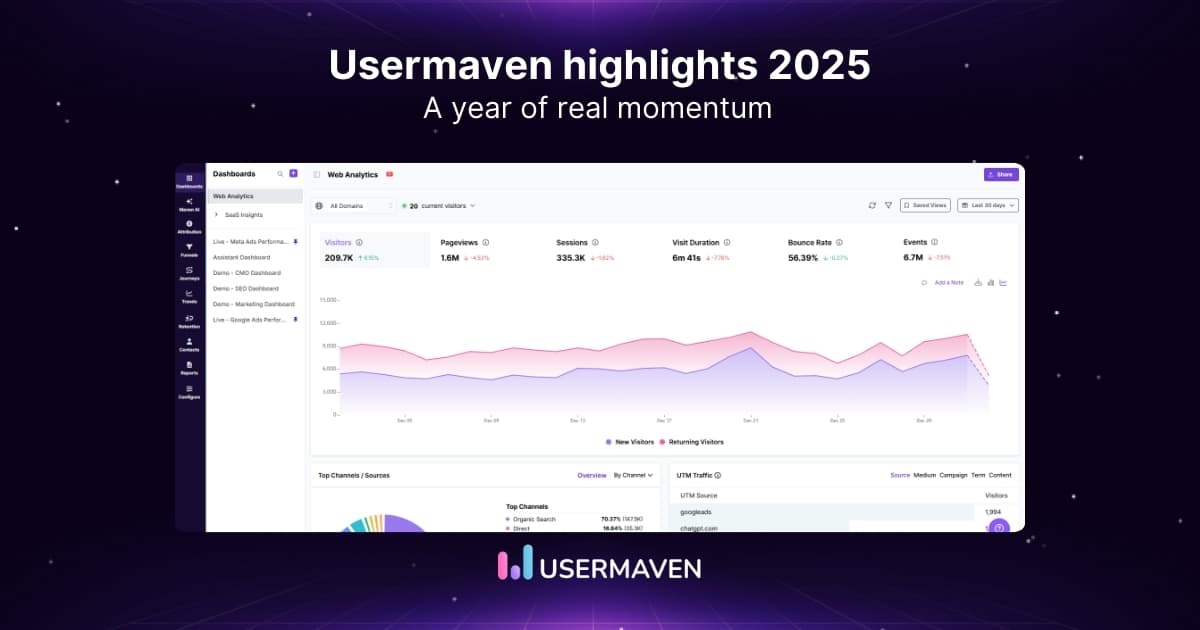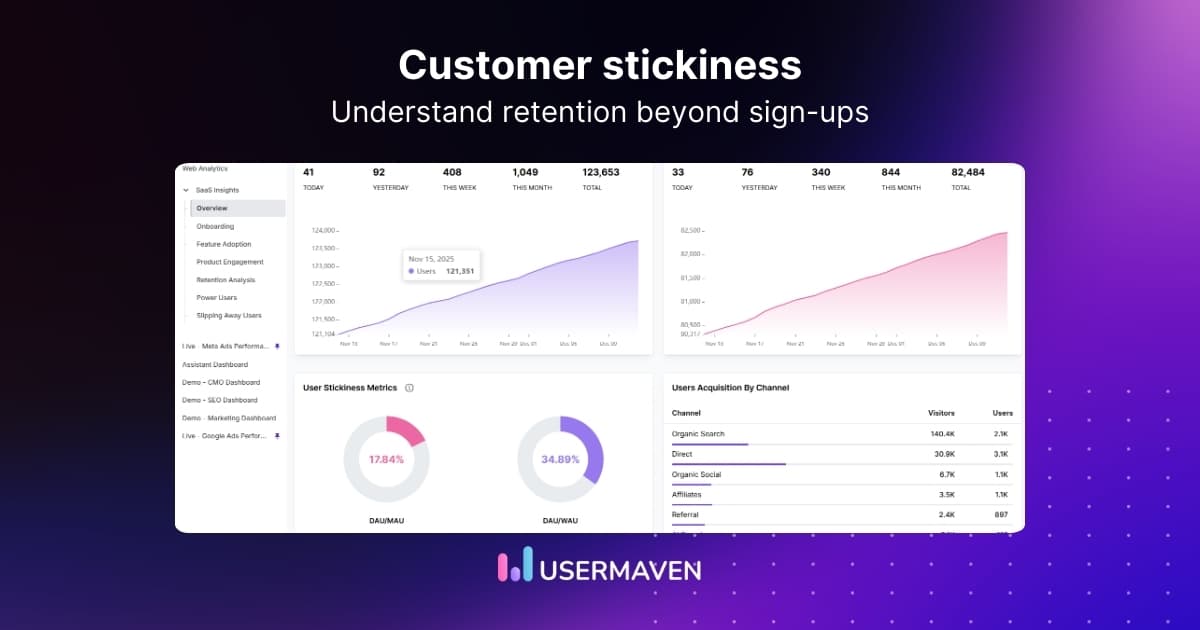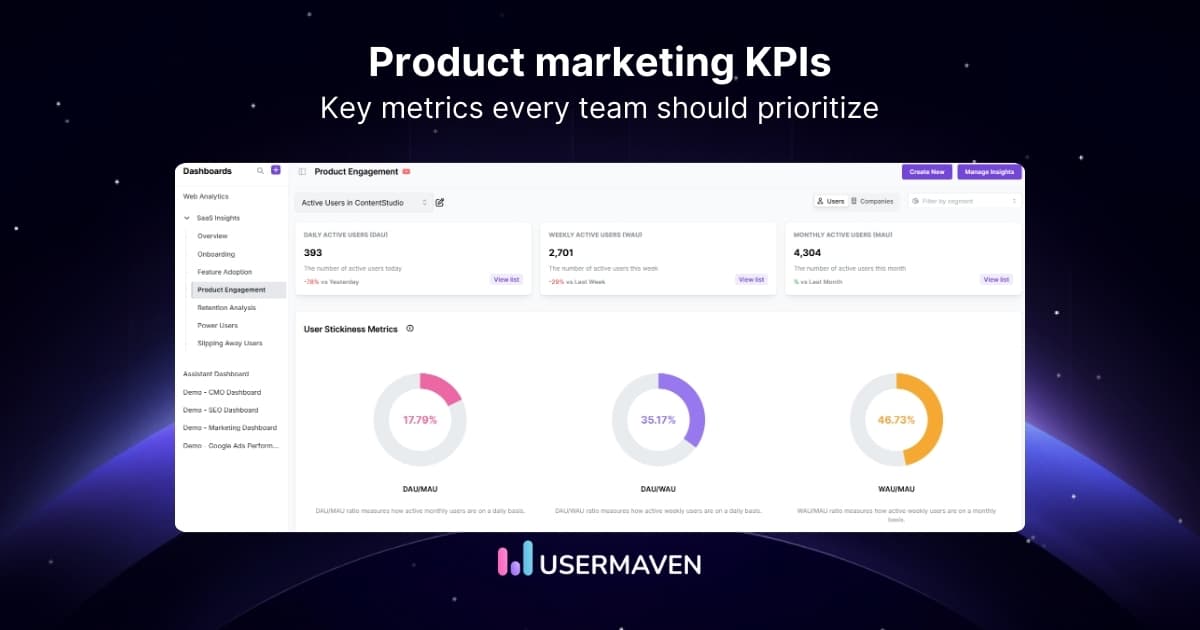Discover 10 best Amplitude alternatives to improve your analytics
Aug 12, 2024
6 mins read
Written by Mahnoor Shahid

In today’s fast-paced digital landscape, businesses demand simple yet powerful analytics solutions to understand user behavior and drive growth. And traditional analytics platforms like Amplitude may not fully meet their evolving needs. Rising costs, scalability challenges, and a steep learning curve have prompted many organizations to explore more adaptable and cost-effective solutions.
In this post, we’ll examine the reasons why brands and agencies are considering alternatives to Amplitude and introduce some of the leading options, like Usermaven, which is known for its privacy-friendly, user-friendly, and affordable analytics.
The need for Amplitude alternatives
Amplitude analytics has its limitations. Some common issues users face include:
- Complexity: The interface can be challenging for new users to navigate.
- Cost: Pricing can escalate quickly, especially for startups or small businesses.
- Customization: Limited flexibility in creating custom reports and dashboards.
As your business grows, so do your analytics needs. You might require:
- More granular data: Detailed insights into user behavior.
- Better integrations: Seamless connectivity with other tools in your tech stack.
- Scalability: A solution that grows with your data volume and complexity.
Top Amplitude alternatives
Here are some of the top-rated amplitude alternatives that we are going to discuss in this blog:
- Usermaven (Top-ranked Amplitude alternative)
- Google Analytics
- Mixpanel
- Heap
- Pendo
- Hotjar
- Chartbeat
- Fathom Analytics
- Plausible
- Simple Analytics
1. Usermaven: The top-ranked Amplitude alternative

“Usermaven is a comprehensive analytics platform designed to provide deep insights into user behavior with a user-friendly interface. It caters to businesses of all sizes, offering remarkable features that make it a top contender among Amplitude alternatives”.
Key features that set Usermaven apart
- AI funnel insights
Leverage Usermaven’s AI-driven funnel insights to optimize user journeys and boost conversion rates. Automatically generated insights help you understand user behavior at each stage of the funnel, identify drop-off points, and make data-driven decisions to enhance your conversion strategy.

- Attribution analysis
Track every customer touchpoint across various channels using seven attribution models (first-touch, last-touch, U-shaped, first-touch nondirect, last-touch nondirect, linear, and time decay). This comprehensive analysis shows which marketing efforts drive the most conversions, helping you optimize your budget and maximize ROI.
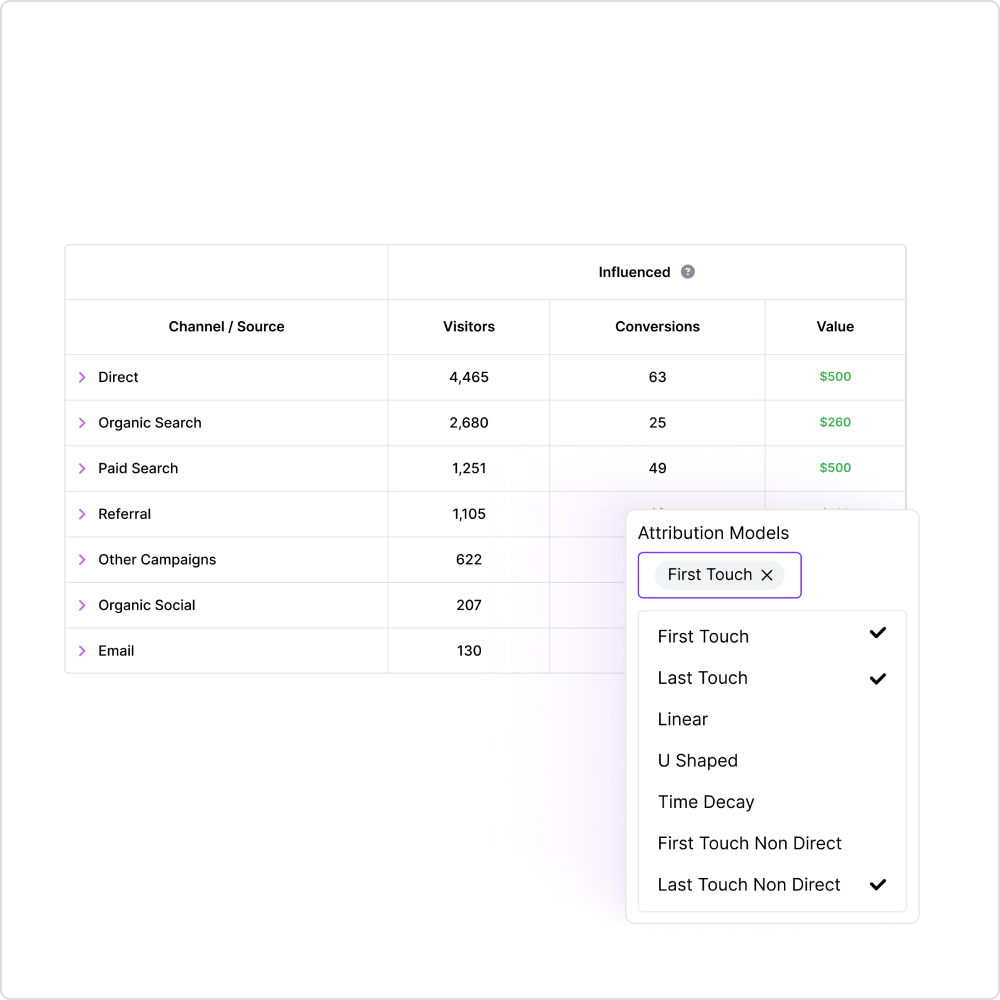
- Feature adoption
Monitor how users are adopting new features within your product. This data helps identify areas where users might need additional training or guidance, ensuring new features deliver their intended value.
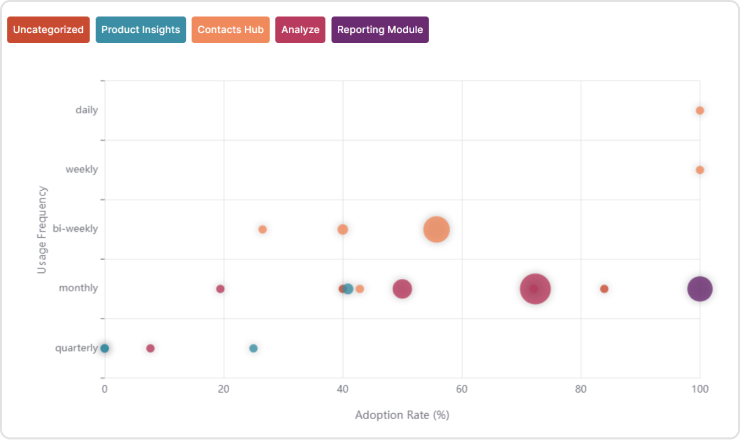
- User journey tracking
Usermaven’s end-to-end journey tracking provides a complete view of a user’s journey on your website or app, allowing you to identify navigation patterns, pinpoint drop-off points, and highlight areas for improvement.
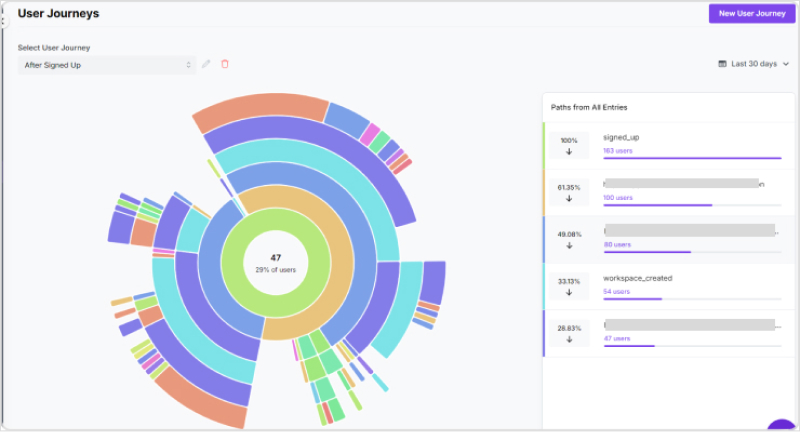
- Segmentation
Create specific user segments based on criteria such as demographics, behavior, or interests. This capability enables you to target distinct user groups with personalized experiences and marketing campaigns.

- Contacts hub
Centralize and manage all your visitor and user details within Usermaven in the Contacts Hub section. This includes website behavior, email interactions, and support tickets, providing a unified view to deliver more personalized and effective customer service.
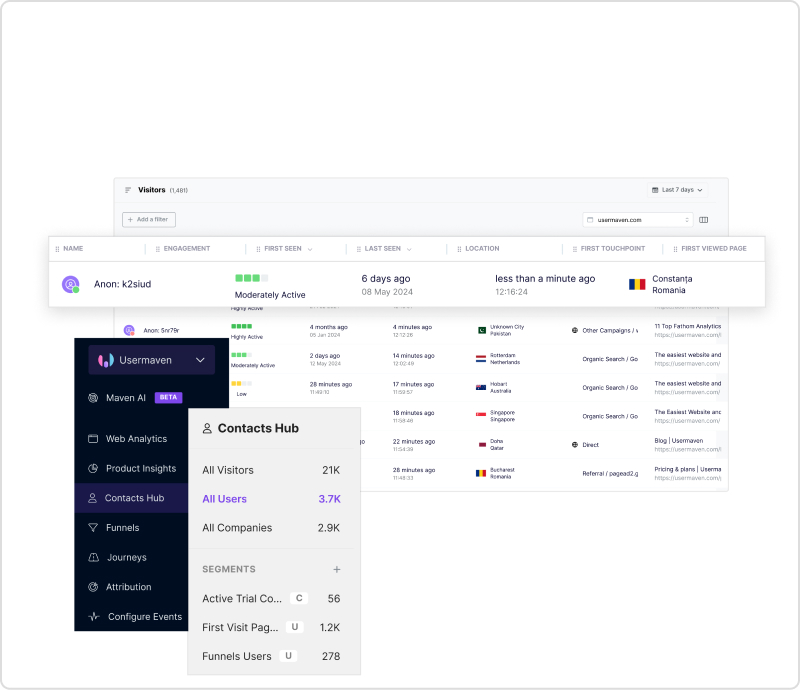
- Onboarding
Gain insights into user progress through your onboarding process with Usermaven. Identify bottlenecks and optimize your onboarding flow to enhance user retention.

- Real-time analytics
Access immediate, real-time data with Usermaven to make prompt, data-driven decisions. Monitor user behavior, campaign performance, and other critical metrics as they happen. This real-time visibility allows you to respond quickly to changes, optimize ongoing strategies, and stay ahead of the competition by leveraging up-to-the-minute insights.

- Cookieless tracking
Ensure compliance with privacy regulations using Usermaven’s advanced cookieless tracking capabilities. Track user behavior and interactions without relying on cookies, safeguarding user privacy while still gaining valuable insights.
![]()
- Maven AI
Usermaven integrated AI assistant, Maven AI, enables you to ask questions in natural language and receive insightful answers directly within the platform. Curious about which feature drives the most conversions? Just ask Maven AI to get the data you need to make quick, informed decisions.
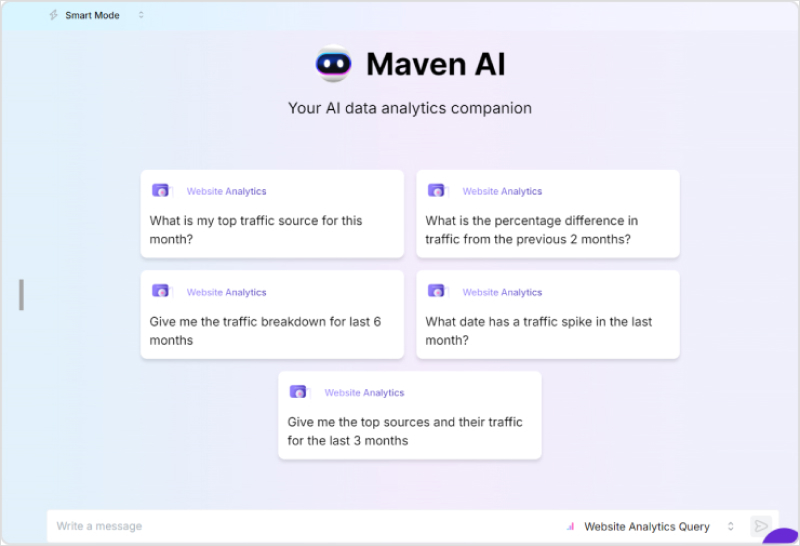
Flexible pricing
- Free trial: Start risk-free with a 30-day trial, providing full access to all features.
- Pro plan ($14/month): Designed to meet basic website analytics needs.
- Premium plan ($49/month): Upgrade to the Premium plan for advanced analytics and CRM functionalities.
- Enterprise plan: Custom-priced Enterprise plans are available for high-traffic websites and specific hosting requirements.
2. Google Analytics

“You could call it an Amplitude alternative, but it’s like bringing a butter knife to a sword fight!”
Features
Google Analytics 4 (GA4) is renowned for its extensive capabilities, including:
- Cross-platform tracking: Monitor user behavior across websites and mobile apps.
- Event-based data model: Flexible and comprehensive tracking of user interactions.
- Enhanced data visualization: Advanced reporting tools for detailed analysis.
- Integration with Google ecosystem: Seamless integration with Google Ads, Search Console, and other tools.
Pricing
- Google Analytics 4 offers two primary pricing options:
- Free tier: Provides basic features suitable for small to medium-sized businesses.
- Google Analytics 360: Custom pricing tailored to meet specific business needs.
Limitations
- Limited data retention (standard accounts keep data for 26 months).
- Sampling of data for high-volume websites can affect accuracy.
- Difficulty in tracking users across multiple devices or platforms.
- Data latency period of 24-72 hours.
3. Mixpanel

“Think of it as an Amplitude alternative, but it’s like using a magnifying glass when you need a telescope—great for close-ups, not so much for the big picture!”
Features
Mixpanel stands out with its focus on user segmentation and advanced analytics:
- Event tracking: Detailed tracking of user actions to understand behavior.
- A/B testing: Test different versions of your product to see which performs better.
- Retention analysis: Gain insights into user retention and identify trends.
- Custom dashboards: Tailor your analytics view to focus on key metrics.
Pricing
- Mixpanel provides a tiered pricing model:
- Free plan: Basic analytics with limited features, ideal for small projects or startups.
- Growth plan: Starting at $28/month, this plan includes advanced analytics, data modeling, and increased data limits. Pricing scales based on usage and additional features.
- Enterprise plan: Custom pricing designed for large organizations with extensive needs, offering full access to all features, dedicated support, and advanced security options.
Limitations
- Can be expensive for high-volume websites or apps.
- Steep learning curve for new users.
- Limited custom reporting options compared to some competitors.
4. Heap

“The Amplitude alternative that’ll leave you in a heap of auto-captured confusion”.
Features
Heap provides powerful real-time analytics with automatic data capture:
- Auto-capture: Automatically track all user interactions without manual event tagging.
- Journey mapping: Visualize user paths and identify drop-off points to improve conversion rates.
- Advanced segmentation: Perform detailed analysis of different user segments.
- Integration capabilities: Easily integrates with other tools and platforms.
Pricing
- Heap provides a tiered pricing model:
- Free plan: Includes core analytics features with limited data capture.
- Growth plan: Custom pricing based on data volume and additional features.
- Pro plan: Custom pricing for businesses requiring extensive analytics capabilities.
- Premier plan: Tailored for large enterprises, offering full access to all features.
Limitations
- Data discrepancies can occur due to its auto-capture feature.
- Retroactive analysis may lead to slower query times for large datasets.
- Potential for information overload due to capturing all user interactions.
5. Pendo

“The Amplitude alternative that guides you through features you didn’t know you didn’t need.”
Features
Pendo is designed with product teams in mind, offering unique features like:
- In-app guides: Create in-app tutorials and messages to guide users through the product.
- Product usage analytics: Understand how users interact with your product to inform development.
- User feedback: Collect and analyze user feedback directly within the app.
- Roadmapping: Plan and prioritize product features based on user data and feedback.
Pricing
- Pendo provides a tiered pricing model:
- Free trial: Available for new users.
- Paid plans: Pricing is available upon request (quote required).
Limitations
- Limited customization options for some features.
- Can be resource-intensive, potentially impacting app performance.
- Lack of advanced segmentation capabilities compared to some alternatives.
6. Hotjar

“The Amplitude alternative that leaves you feeling a bit flat on the analytics scale.”
Features
Hotjar excels in visualizing user behavior through:
- Heatmaps: Visual representation of where users click, move, and scroll on your site.
- Session Recordings: Record user sessions to see exactly how they interact with your site.
- Feedback Polls: Collect real-time user feedback to improve user experience.
- Surveys: Conduct surveys to gather in-depth insights on user experience and satisfaction.
Pricing
Hotjar offers a free basic plan, a Plus plan at $32/month, and a Business plan starting at $80/month.
Limitations:
- Limited storage for recordings and heatmaps on lower-tier plans.
- Privacy concerns due to session recordings (may capture sensitive user data).
- Sampling of data for high-traffic websites which may affect the accuracy of insights.
7. Chartbeat

“The Amplitude alternative that’ll leave you beating your head against the chart for more insights.”
Features
Chartbeat is ideal for publishers and content creators, offering:
- Real-time analytics: Monitor real-time traffic and user engagement on your content.
- Content performance: Analyze how different pieces of content are performing.
- Audience insights: Understand who your readers are and how they engage with your content.
- Headline testing: Test different headlines to see which ones drive more engagement.
Pricing
Chartbeat offers customized pricing plans tailored to specific business needs, website traffic, and required features. Detailed pricing information is available upon request or through direct consultation with their sales team.
Limitations
- Primarily focused on real-time analytics, with limited historical data analysis.
- More suitable for content-based websites and less versatile for e-commerce or SaaS.
- Relatively expensive compared to some alternatives, especially for smaller websites.
8. Fathom Analytics

“The Amplitude alternative that’s so privacy-focused, it hides insights from you too.”
Features
Fathom Analytics is known for its simplicity and privacy-first approach:
- Privacy compliance: Fully compliant with GDPR, CCPA, and other privacy laws.
- Simple dashboards: Easy-to-understand analytics dashboards.
- Fast loading: Minimal impact on website loading speeds.
- Unlimited data: No data sampling or limitations.
Pricing
Fathom Analytics offers clear pricing plans based on the number of websites and page views tracked:
- Up to 100,000 data points: $15 per month
- Up to 1,000,000 data points: $60 per month
- Up to 25,000,000 data points: $470 per month
- Over 25,000,000 data points: Contact Fathom Analytics for a custom quote
Limitations
- Limited advanced features compared to more comprehensive tools.
- No user-level data or behavior flow analysis.
- Fewer integration options with other marketing tools and platforms.
9. Plausible

“The Amplitude alternative that’s implausibly basic for your complex analytics needs.”
Features
Plausible offers a lightweight and privacy-friendly analytics solution:
- Open source: Transparency and flexibility with open-source code.
- Privacy-focused: Compliant with GDPR, CCPA, and PECR.
- Simple interface: User-friendly dashboards and reports.
- Custom events: Track custom events easily.
Pricing
Plausible provides transparent pricing plans based on monthly page views. As of the latest updates:
- Growth: Starting at $9 per month
- Business: Starting at $19 per month
- Enterprise: Custom pricing available
Limitations
- Basic feature set, lacking some advanced analytics capabilities
- No support for custom event tracking (as of my last update)
- Limited historical data retention (12 months on the standard plan)
10. Simple Analytics

“The Amplitude alternative that’s so simple it might just analyze your coffee breaks.”
Features
Simple Analytics focuses on providing clean and privacy-respecting analytics:
- No cookies: Cookie-free analytics to respect user privacy.
- Clear insights: Simple and easy-to-understand reports.
- Privacy laws compliance: Compliance with GDPR, CCPA, and PECR.
- Fast performance: Minimal impact on site performance.
Pricing
Simple Analytics provides a free plan with limitations. Paid plans are based on the number of page views and events tracked, with charges increasing according to data usage. Monthly and yearly payment options are available.
Limitations
- Minimal feature set, which may not be sufficient for complex analytics needs
- No user-level tracking or behavior analysis
- Limited customization options for reports and dashboards
Which is the best Amplitude alternative?
Choosing the right Amplitude alternative depends on your specific needs and budget. Let’s break down how Usermaven stacks up against the competition:
- Google Analytics: While powerful, Google Analytics often lacks the depth and customization needed for advanced user behavior analysis. Usermaven offers a more intuitive interface and deeper insights into user journeys.
- Mixpanel: Strong in product analytics, Mixpanel can be costly and complex. Usermaven provides a more comprehensive solution with AI-driven insights and a user-friendly experience.
- Heap: Known for auto-capture, Heap can be overwhelming with data. Usermaven strikes a balance, offering automated insights without sacrificing control.
- Pendo: Focused on product adoption, Pendo lacks comprehensive analytics capabilities. Usermaven combines product analytics with in-depth user behavior insights.
- Hotjar: Excellent for user experience research, Hotjar falls short in advanced analytics. Usermaven offers a broader range of features, including AI-powered insights and attribution analysis.
- Chartbeat, Fathom Analytics, Plausible, and Simple Analytics: Primarily focused on website traffic and basic analytics, these tools lack the depth and features of Usermaven.
Usermaven emerges as the most comprehensive and user-friendly Amplitude alternative. It combines the power of advanced analytics with AI-driven insights, making it the ideal choice for businesses seeking to understand their users deeply and make data-driven decisions.
Conclusion
Choosing the right analytics tool is crucial for understanding user behavior and making informed decisions. While Amplitude is a strong option, exploring alternatives like Usermaven can help you find the best fit for your specific needs.

FAQs
1. Why consider alternatives to Amplitude?
Alternatives like Usermaven offer more suitable features, better pricing, or a more intuitive interface that fits your business needs better.
2. Can small businesses benefit from these alternatives?
Yes, many of these tools, like Usermaven, offer free or affordable plans designed specifically for small businesses.
3. How do pricing models vary among these alternatives?
Pricing models range from free tiers and flat monthly fees to custom enterprise pricing, depending on the tool and features required.
Try for free
Grow your business faster with:
- AI-powered analytics & attribution
- No-code event tracking
- Privacy-friendly setup

